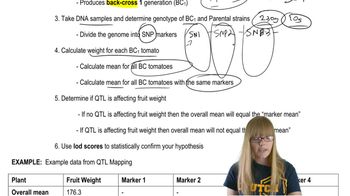In a cross of two pure-breeding lines of tomatoes producing different fruit sizes, the variance in grams (g) of fruit weight in the F₁ is 2.25 g and the variance among the F₂ is 5.40 g. Determine the genetic and environmental variance (VG and VE) for the trait and the broad sense heritability of the trait.
Table of contents
- 1. Introduction to Genetics51m
- 2. Mendel's Laws of Inheritance3h 37m
- 3. Extensions to Mendelian Inheritance2h 41m
- 4. Genetic Mapping and Linkage2h 28m
- 5. Genetics of Bacteria and Viruses1h 21m
- 6. Chromosomal Variation1h 48m
- 7. DNA and Chromosome Structure56m
- 8. DNA Replication1h 10m
- 9. Mitosis and Meiosis1h 34m
- 10. Transcription1h 0m
- 11. Translation58m
- 12. Gene Regulation in Prokaryotes1h 19m
- 13. Gene Regulation in Eukaryotes44m
- 14. Genetic Control of Development44m
- 15. Genomes and Genomics1h 50m
- 16. Transposable Elements47m
- 17. Mutation, Repair, and Recombination1h 6m
- 18. Molecular Genetic Tools19m
- 19. Cancer Genetics29m
- 20. Quantitative Genetics1h 26m
- 21. Population Genetics50m
- 22. Evolutionary Genetics29m
3. Extensions to Mendelian Inheritance
Overview of interacting Genes
Problem 7e
Textbook Question
Provide a definition and an example for each of the following terms:
Quantitative trait locus
 Verified step by step guidance
Verified step by step guidance1
A quantitative trait locus (QTL) is a region of the genome that is associated with a quantitative trait, which is a trait that varies continuously and is influenced by multiple genes and environmental factors. Examples of quantitative traits include height, weight, and crop yield.
To identify a QTL, researchers typically use statistical methods to link variations in DNA markers (such as SNPs or microsatellites) with variations in the quantitative trait of interest.
An example of a QTL study could involve mapping regions of the genome associated with plant height in a population of hybrid plants. By analyzing the genetic markers and their correlation with height measurements, researchers can identify specific genomic regions that contribute to height variation.
QTLs are often identified using techniques such as linkage mapping or genome-wide association studies (GWAS), which involve analyzing the inheritance patterns of traits in a population.
Understanding QTLs is important for applications such as selective breeding in agriculture, where identifying genomic regions associated with desirable traits can help improve crop or livestock characteristics.
 Verified video answer for a similar problem:
Verified video answer for a similar problem:This video solution was recommended by our tutors as helpful for the problem above
Video duration:
2mPlay a video:
Was this helpful?
Key Concepts
Here are the essential concepts you must grasp in order to answer the question correctly.
Quantitative Trait Locus (QTL)
A Quantitative Trait Locus (QTL) is a specific region of DNA that is associated with a particular quantitative trait, which is a measurable phenotype that varies continuously, such as height or weight. QTLs are identified through statistical analysis of phenotypic data and genetic markers, allowing researchers to understand the genetic basis of complex traits.
Recommended video:
Guided course

QTL Mapping
Phenotype
Phenotype refers to the observable characteristics or traits of an organism, which result from the interaction of its genotype (genetic makeup) with the environment. Examples of phenotypes include physical attributes like color, size, and shape, as well as behavioral traits. Understanding phenotypes is crucial for studying QTLs, as they are the traits that QTLs influence.
Recommended video:
Guided course

Mutations and Phenotypes
Genetic Markers
Genetic markers are specific sequences in the genome that can be used to identify individuals or species and track inheritance patterns. They serve as reference points in genetic mapping studies, including QTL mapping, where they help researchers correlate specific regions of the genome with phenotypic traits. Common types of genetic markers include single nucleotide polymorphisms (SNPs) and microsatellites.
Recommended video:
Guided course

Mapping with Markers

 7:56m
7:56mWatch next
Master Interacting Genes Overview with a bite sized video explanation from Kylia
Start learningRelated Videos
Related Practice
Textbook Question
443
views
